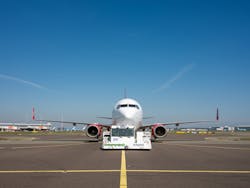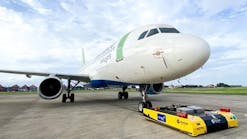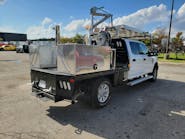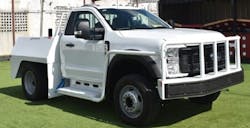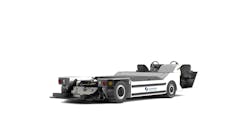As airports and airlines around the world seek to reduce pollution, battle congestion between the ramp and taxiway and make operations more efficient, many are turning to the latest technology for answers.
At Schiphol Airport (AMS) in Amsterdam, stakeholders from the airport, airlines and ground operations came together to examine how aircraft could taxi more efficiently to help all entities meet long-term sustainability goals.
Field trials for TaxiBot, invented by Israel Aerospace Industry (IAI), designed and built by TLD and IAI and powered by technologies developed by TLD’s sister company Smart Airport Systems (SAS), began earlier this year to better understand how the semi-robotic tractor could help airlines and Schiphol further reduce emissions and improve operations.
“As an airline, there’s not a lot of potential to improve your environmental footprint – your sustainability – when you’ve bought the latest generation of aircraft,” explains Vincent Metz, EVP of business development at SAS. “Once you fly the 787s, the A220s, the 777 Max or the Neo, biofuel is the only available option to further reduce your emissions in flight ... but scaling up biofuel will still take 10 to 20 years.”
With less room for improvement in the air, Metz says an airline should focus on what can be done on the ground to decrease its environmental impact. There, big steps can be made with technology that is available today. Solutions like TaxiBot, can help in this area by limiting the amount of time an aircraft’s engines are running and, hence, reduce fuel burn while taxiing to the runway.
“If you see what parts of the flight where we can still really improve drastically, then it’s obviously in departing from the ground,” Metz says. “The use of engines is really not necessary. And if you see the total pollution that you can save by not doing it, it’s quite significant.”
By not using aircraft engines near the terminal, reduction of the local acute emissions, like Nitrogen, fine dust and other pollutants that can be harmful to ground personnel, also can be achieved.
“The reduced emissions, especially locally, are of great importance to the airport,” explain Simon Prent and Dirk Bresser, innovators of autonomous airside operations at Schiphol. “Less noise and pollution make the airport a better working and living environment.”
How it Works
TaxiBot is a semi-robotic tow vehicle. It is controlled by the pilot of the aircraft as the tractor tows the plane from the terminal to the runway. Because this is done without the use of the aircraft’s engines, a significant amount of jet fuel is preserved.
“TaxiBot offers advantages for Schiphol’s set-up, as less taxiing time and less fuel usage is required to get aircraft to the runway and ready for take-off,” say Prent and Bresser, adding departing aircraft at Schiphol take approximately 14 minutes to taxi, and arriving aircraft take approximately 9 minutes to taxi to the gate.
Additionally, TaxiBot is powered by a hybrid of electric and diesel engines that allow for further green operations.
Metz describes the relationship between TaxiBot and the aircraft as that of dance partners. TaxiBot follows the lead of the aircraft. When the combination of the tractor and plane is in Pilot Mode, the pilot of the aircraft is steering the entire combination.
“TaxiBot is reading the inputs that the pilot gives by the angle of the nose landing gear and TaxiBot is following that as the direction,” says Metz.
“The principle of TaxiBot is that they basically reversed the logic,” he continues. “It’s the aircraft that does the braking – so the pilot uses the normal brakes of the airplane. And there’s a very advanced and sensitive measurement system in TaxiBot that really feels, ‘the aircraft is slowing down, now I also have to slow down TaxiBot.’”
The predominant reason TaxiBot is designed the way it is, explains Metz, is due to strict rules from aircraft manufacturers regarding the loads that are put on the nosewheel landing gear.
“It’s both the absolute loads and the fatigue pattern,” Metz explains.
“With a normal pushback tractor, they of course, put force on the nose landing gear, but it’s still at a very low speed and for a very short duration,” he adds. “But if you do longer distance, high-speed taxiing – certainly if you’re taxiing with an aircraft full of fuel and full of passengers – then the loads become higher than acceptable.”
TaxiBot is programmed based on the airport map, that identifies precisely the maximum permitted speed for each area. TaxiBot will accelerate to this maximum speed allowed in a given area, unless the pilot applies the brakes and slows down the combination.
“For a pilot, it’s very, very natural,” Metz says. “There’s no practical training, there’s no simulator training, it’s only a computer-based training of less than 40 minutes that can be done just before the first 'TaxiBoting' mission. This is half an hour to be certified by Airbus and Boeing and the feedback we get from pilots is that it is sufficient for them.
“It shows how close the experience is to normal taxiing.”
This taxiing process has worked well at Schiphol, which faces challenges regarding gate availability because of the many gates at its lone terminal.
Unlike in the U.S., where outbound holding is common and aircraft wait to depart on the taxiway, aircraft at Schiphol wait at the gate until they are able to depart.
“From a gate utilization perspective, the Amsterdam system is not the best,” says Prent and Bresser. However, they note the system as advantages because there is less pollution.
In Amsterdam, and at many airports across Europe, ground movements are dictated by ground control, which is often part of the air navigation service provider (ANSP) as opposed to the U.S. where ground movements are mostly coordinated by the airport’s apron control personnel. Prent and Bresser explain this effectively results in the ANSP becoming an additional stakeholder in the process.
The new vehicle and taxi method had to be incorporated into air traffic control rules and organization at the airport. Rather than receiving pushback clearance from the tower and then seeking clearance to taxi out shortly after, TaxiBot allows for those two calls to be integrated into one, reducing workload for ATC and eliminating wait time to receive clearance.
“The advantage with TaxiBot is that you can basically directly leave. You do the pushback, you switch to Pilot Mode and then the combination can directly taxi out,” Metz says. “It reduces the ground time of the aircraft, but also really reduces the period that TaxiBot is blocking the gate. The gate availability is also going up.”
According to Metz, it’s possible to start the engines of the aircraft while behind TaxiBot.
“The idea is you taxi until you are as close as possible to the runway and then in the last phase, you start the engines of the aircraft,” he explains. “You don’t have to stand still to do the engine start. You gain ground time as a result.
“You just have to de-couple close to the runway and then you can take off.”
Schiphol Trials
TaxiBot trials began in March at Schiphol with a goal of validating the benefits of reducing fuel consumption and emissions while testing the speed of taxiing.
From an airport’s perspective, the most promising part of TaxiBot technology is the possibility to reduce emissions,” say Prent and Bresser. “Royal Schiphol Group's vision is to create the world’s most sustainable, high-quality airports and aims to have the airports emission-free by 2030.
“Schiphol wants to take care of its employees, its passengers and citizens living around the airport,” they continue. “So, CO2 emissions are important, but reduction of ‘local emissions’ such as ultra-fine particles, NOx and noise are too. This is where sustainable taxiing really makes a difference.”
Due to the impact of the coronavirus, officials temporarily halted the trial for about a month until a new method was established, allowing the trial to restart with fewer people on site and allowing them to social distance.
However, the impact of the pandemic also offered opportunities.
“It was relatively quiet on airside, with less other traffic,” explain Prent and Bresser. “Therefore, we were able to test anything we wanted. In the original plan, we would carry out the trial with empty planes at night. Due to corona, we performed our test during the day.”
According to Prent and Bresser, 170 missions were performed during the trial period that concluded in mid-August.
“We tested the impact on the flow, but also the difficulty of using the TaxiBot in daily operations. We introduced the technology to our stakeholders and got a better view on the challenges connected to it,” they explain.
The airport’s representatives had hypotheses in different categories, including fuel reduction, TaxiBot’s performance and the process of implementing the equipment. Some of the items now being investigated include how sustainable taxiing can be integrated into daily operations, whether it is achievable on a large scale and how long and in what time period the transition phase should be, explain Prent and Bresser.
“Together with Air Traffic Control The Netherlands (LVNL), we are now working on a simulation based on the data from the operational tests; what if there are several TaxiBots driving around Schiphol at the same time?” they say. “We are combining the results of the simulation and the missions in a feasibility study, which will be completed by the end of the year.”
The relatively long taxi times at Schiphol proved to be an advantage as fuel usage reduction is a function of taxi time. Total taxiing fuel can be reduced by 50-85%, according to Prent and Bresser.
“These fuel savings represent potentially dozens of millions of Euros at Schiphol and they can more finance the acquisition and operations of the TaxiBots,” notes Metz. “This is typically a case of the new Green economy where the environmental solution brings direct economic advantages to the airlines.”
That combination of ecological impact and economic viability has been demonstrated by the “Solar Impulse” label that the TaxiBot received about a year ago. The Solar Impulse foundation, created by Bertrand Piccard, has a clear purpose which is to boost the adoption of profitable solutions to protect the environment.
“In addition, using a TaxiBot reduces issues with blast,” Prent and Bresser point out. “With the TaxiBot, blast is reduced and the airport’s capacity can be used to the fullest, without safety issues. There is no need to start-up engines in the busy bay areas around gates. This means less time in the busiest area of the airport. This reduces congestion and, again, increases gate capacity.”
What’s more, the airport works hard to reduce foreign object debris (FOD) and the damage it can cause aircraft engines.
“Both the airport and airline will benefit greatly from the reduced FOD costs due to the fact that the engines are not running in the most FOD-prone areas around the gates,” say Prent and Bresser.
The tests at Schiphol were conducted with KLM, Transavia and Corendon Dutch Airlines, along with their ground handling partners, KLM Ground Services and dnata.
“All parties see the potential but also see that their processes change,” explain Prent and Bresser. “There are numerous conditions and recommendations that we are bringing together in the feasibility study reports we are currently finishing up.”
Additional Opportunities
While the initial trials have concluded and TaxiBots are in live operation at airports in Bangalore and Delhi, more is still being done to understand the viability of TaxiBot operations at Schiphol, specifically.
For example, the taxi process can also be reversed to assist aircraft coming in, which is currently being studied and organized at Schiphol to achieve additional environmental benefits.
Further efficiencies in the ground support equipment are also being sought.
“What we have today is a version that is driven by diesel engines. One of the technology developments we are looking at, together with Schiphol, is to see if we can make a fully electrical TaxiBot to practically generate zero emissions,” Metz says. “Although, that only adds a very limited amount of pollution reduction.
“The other part is a strong ambition to make it autonomous,” he adds, noting regulatory issues with autonomous technology that cross taxiways pose some challenges.
Schiphol has a long-term goal of achieving 100% sustainable taxiing at the airport by 2030.
With an environmental approach spearing Schiphol’s project, Metz believes TaxiBot technology can generate additional interest.
“It’s really a multi-stakeholder challenge. You have to involve the airport, ATC, the pilots, the airlines and the ground handling companies,” Metz says. “If it’s only the airline going for fuel savings, it’s sometimes difficult to motivate all the other stakeholders to contribute.”
However, since environmental challenges are often seen as key for airports, it can help align the necessary stakeholders to make it work. Metz says the Schiphol project is evidence of this.
“I think as an industry, we need to be very self-aware that we are quite conservative when it comes to really changing the way we do things,” Metz adds. “The challenges we have now, and maybe after COVID, it forces us to rethink a little bit about the way we operate. Also, with all the environmental challenges, we really need to embrace change instead of trying to find reasons not to act when solutions are existing.
“In a highly regulatory environment, like flying, it’s always easy to find arguments why things can’t be done. Having worked also in the maintenance side of aircraft, I know that if you really want to, there are always safe ways to make things happen,” he continues. “I think that’s the spirit we need to find in our industry.”
